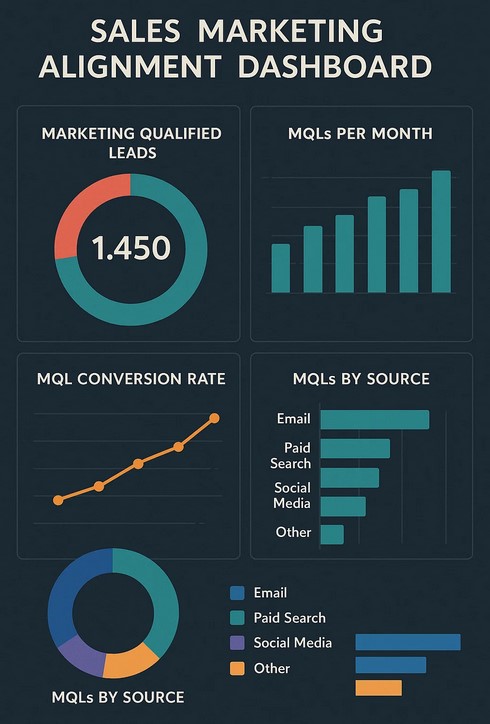
September 21, 2025
This guide is for B2B marketing and revenue teams using Salesforce Marketing Cloud or planning a move. If you’re aiming to scale B2B marketing automation with cleaner handoffs, stronger lead nurturing campaigns, practical account-based marketing plays, clear marketing qualified leads (MQL) criteria, and tighter sales marketing alignment, you’re in the right place. We’ll walk through field-tested approaches Tejas uses across rollouts, backed by Salesforce best practices.
What is B2B marketing automation in Salesforce Marketing Cloud?
It’s the process of using Salesforce Marketing Cloud and Marketing Cloud Account Engagement to capture leads, score fit and intent, run lead nurturing campaigns, trigger alerts for the sales team, and report on pipeline impact, without manual busywork.
Why does B2B marketing need automation today?
B2B cycles stretch across many touches and multiple roles. Manual campaigns fall behind, leads sit unworked, scoring methods drift, and reporting gets fuzzy. B2B marketing automation inside Salesforce Marketing Cloud replaces the guesswork with repeatable playbooks and governed data flowing between marketing and Sales.
Quick reality check:
- Buying groups change mid-cycle. Automation keeps journeys current.
- Compliance rules tighten. Central governance reduces risk.
- Pipeline targets rise. Always-on lead nurturing campaigns protect the top of the funnel.
How does Tejas implement SFMC for B2B teams?
Tejas pairs Salesforce Marketing Cloud strategy with fast, phased delivery, measured in weeks, along with strong security practices and integration standards. Our teams in the US, UK, India, and Mexico handle configuration, data hygiene, and change management so marketing can move without friction.
Rollout approach (high level)
- Foundation: data model alignment, tracking, consent settings.
- Journeys and lead nurturing campaigns: quick wins first, scale after.
- Governance: scoring rules, MQL thresholds, naming, folders, and user acceptance testing (UAT).
- Handoffs: Sales alignment and alerts wired through CRM.
Want an implementation plan tailored to your stack? Schedule a demo and we’ll map week-by-week milestones.
Which Salesforce Marketing Cloud capabilities matter the most in B2B?
Marketing Cloud Account Engagement (formerly Pardot) handles capture, grading, scoring, lead nurturing campaigns, and Sales alerts. Engagement Studio drives behavior-based flows; Engagement History shows impact in CRM.
- CRM integration ties campaign influence, activities, and tasks back to Sales Cloud for the sales team to act fast.
- Journey Builder orchestrates messages across channels at scale.
How do we define MQLs and promote them cleanly to Sales?
MQLs work when everyone shares the same, simple rules. Start with two signals you can explain in a sentence: fit (firmographic) and intent (behavioral).
Simple worksheet
| Component |
Example rule |
Owner |
| Fit score |
ICP industry + company size |
Ops |
| Intent score |
Pricing page visit + webinar attendee |
Marketing |
| Marketing qualified leads threshold |
Fit ≥ B and Intent ≥ 80 |
Joint |
| Routing |
Auto-assign by territory, create task, SLA 24h |
Ops |
| Recycle |
If unqualified, revert to Nurture segment |
Marketing |
How to run this day-to-day
- In Salesforce Marketing Cloud Account Engagement, set grading and scoring, then add an automation rule that flags marketing qualified leads the moment they meet the threshold.
- Push them to the Sales Cloud with an owner, a due task, and a quick alert, so the sales team can act while the interest is fresh.
- Review SLA and acceptance on a shared dashboard each week; it keeps sales and marketing alignment real and visible.
Need a template? We’ll share our scoring matrix during a discovery call. Talk to Tejas.
What does an effective lead nurturing program look like?
Great lead nurturing campaigns feel timely and helpful.
- Early stage: short notes that name one problem and one next step; share one solid resource (guide or checklist).
- Consideration: prove you’re a match: offer a side-by-side comparison, a quick demo clip, and clear trade-offs.
- Late stage: proof: real customer story, clear results, answers to common security and purchasing questions.
Quick checklist
- One audience, one goal.
- Set a clear end date (about 2-3 weeks).
- Add different paths for small vs. large companies or for different job roles if they act differently
- Stop the messages as soon as a salesperson gets in touch.
A tiny example
A webinar attendee revisits pricing.
- Mark the person as highly interested.
- Send a short follow-up with the recording and a comparison sheet.
- If they open the comparison link, send a follow-up with a customer story and an invite to a short call
- Create a task for the salesperson and pause the messages once they reply.
Set this up in your marketing tool, and show recent activity on the lead record so the sales team knows what happened before reaching out.
How do multi-channel journeys run in Journey Builder?
You’ll design a single flow that uses email, mobile, and paid media with decision splits and waits based on CRM and web events inside Salesforce Marketing Cloud. Start simple: one trigger, a branch for target accounts vs. others, a conditional wait, Sales alert, then recycle or handoff.
How should ABM run on Salesforce?
Account-based marketing works when targeting, orchestration, and measurement align:
- Targeting: define buying groups and account scores.
- Orchestration: 1:few or 1:1 plays across email, ads, sales development steps (SDR), and executive touches.
- Measurement: Engagement History + CRM Analytics/B2BMA dashboards to show lift on meetings, pipeline, and revenue.
Want ABM target lists, buying signals, and sales alerts working together in Salesforce?
Book a Tejas working session for Salesforce Marketing Cloud
How do sales and marketing stay aligned with Salesforce?
Strong sales marketing alignment shows up in daily habits and shared numbers. Use one simple setup everyone can live with:
- One lifecycle map: Inquiry → marketing qualified leads → SAL → SQL → Pipeline. Publish the definitions in Salesforce so they’re visible on every lead and contact.
- One live dashboard: time to first response, MQL acceptance rate, stage movement, and missed SLAs. Pin it to both the Marketing and Sales home tabs; skip exported decks.
- One weekly review (20 minutes): open the same dashboard, agree on the wins, call out stuck handoffs, assign two fixes, then move on.
- Clean handoffs: auto-assign owner, create a task with a due time, and send a short alert when an MQL lands.
- Closed-loop notes: when a lead is recycled, capture the reason with a picklist (no budget, wrong role, timing). Feed that back into scoring and nurture content.
Glossary: sales-accepted lead (SAL) = accepted by sales; sales-qualified lead (SQL) = validated opportunity; SLA = response-time agreement.
This keeps the conversation grounded in facts and makes it easy for the sales team to act while interest is still warm.
Tejas sets up joint dashboards so sales and marketing alignment becomes a habit, not a slide.

Where does Data Cloud help B2B teams?
When accounts interact across site, product, support, and events, Data Cloud unifies profiles and activates segments in real time across Salesforce Marketing Cloud journeys. Use it to route signals like “renewal risk” or “upsell fit” into journeys and Sales alerts.
How do we measure and report properly?
Two pillars:
- Attribution: time-decay or position-based models work well for long cycles; validate against opportunity data.
- Insight layers: Engagement History for campaign influence, CRM Analytics/B2BMA for multi-touch and velocity.
Weekly dashboard short list
- MQL acceptance rate (target: 70%+)
- Time to first response on MQLs (target: <24 hours)
- SAL→SQL conversion rate (target: 30–40%)
- Opportunity velocity by campaign (days between stages)
- Marketing-sourced pipeline added (this week, this quarter)
Is Tejas the right Salesforce Marketing Cloud partner for our team?
If you already run Sales Cloud or plan to, the native alignment is hard to beat. Tejas builds on that foundation with connected operations like Tejas OMS (TOMS), Tejas WMS (TWMS), Salesforce Order Management services, Salesforce Service Cloud so marketing signals meet fulfillment and support data when needed.
How do we get started quickly and safely?
Field plan (condensed):
- Audit and align: lifecycle, MQL rules, consent, tracking.
- Stand up Account Engagement: users, folders, naming, scoring, Engagement Studio for your first lead nurturing campaigns.
- Wire CRM handoffs: tasks, alerts, dashboards for sales marketing alignment.
- Launch journeys: one multi-channel journey in Salesforce Marketing Cloud; expand after results.
- Iterate: test subject lines, audit deliverability, roll ABM for top accounts.
Want a two-week starter plan? Talk to Tejas. We’ll tailor a sprint roadmap to your data and goals.
Conclusion
Marketing teams don’t need more noise; they need steady pipeline. If your team is ready to move from scattered campaigns to a scalable system on Salesforce Marketing Cloud, Tejas will guide the setup, connect the data, and keep momentum steady. Schedule a Demo and let’s map the next quarter’s revenue moves together.
Key Takeaways
- Define MQLs with fit + intent, automate routing, and show SLA performance on one shared dashboard.
- Build simple lead nurturing campaigns with clear stages, short cadences, and stop rules when Sales engages.
- Run account-based marketing by aligning target lists, signals, and measurement across Account Engagement, Sales Cloud, and CRM Analytics.
- Use Journey Builder for one multi-channel flow first; expand after results.
- Strengthen sales marketing alignment with one lifecycle map, one live dashboard, and a weekly 20-minute review.
FAQs
What’s the difference between Marketing Cloud Account Engagement and Marketing Cloud Engagement?
Account Engagement focuses on B2B demand generation and B2B marketing automation (scoring, grading, lead nurturing campaigns). Marketing Cloud Engagement (Journey Builder, Email Studio, etc.) handles cross-channel orchestration at scale.
How should we set an MQL threshold?
Blend fit + intent, pressure-test with Sales for quality, and monitor accepted rate. Marketing qualified leads should convert to SAL within your SLA window.
Where does ABM fit in Salesforce?
Targeting and orchestration run across Account Engagement, Sales Cloud, and Data Cloud, with B2BMA/CRM Analytics for measurement. Account-based marketing thrives when the buying group is clearly mapped.
What are common early wins?
One nurture flow for your highest-intent segment, a clear MQL rule, and a joint dashboard for sales marketing alignment.